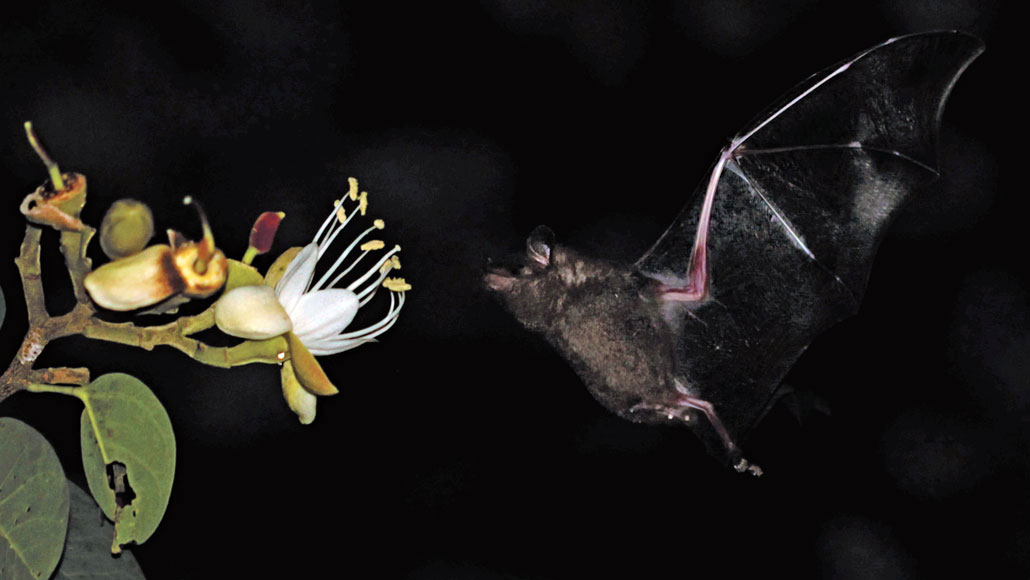
A Pallas’s long-tongued bat approaches the flower of a Hymenaea cangaceira tree, one of only two trees known to have flowers that produce a drizzle of nectar.
A. Domingos de Melo
It’s night, and plant biologist Arthur Domingos de Melo is looking up at the open, ivory flowers of a tropical, hardwood tree. Though it’s the dry season in the arid, thorny Caatinga region of northeast Brazil, a slow drizzle begins to fall. But not from the sky. Domingos de Melo is under the tree’s canopy, and the “rain” is sweet.
Behold Hymenaea cangaceira, a species whose flowers make so much nectar that it overflows and falls in unusually copious and fragrant showers, even though the price of water in this part of the world is steep.
Domingos de Melo and colleagues at the Universidade Federal de Pernambuco in Recife, Brazil, had been studying bat pollination of local plants for two decades in the region when, in 2015, one type of bat-pollinated tree struck them as odd. Its nectar, rather than just the flower petals, was imbued with its own perfume — a phenomenon poorly understood in bat-pollinated plants — and the plant made loads of it.
From 2015 to 2018, the team studied a population of H. cangaceira in Brazil’s Catimbau National Park. Each day after sunset during the trees’ reproductive season, between December and March, hundreds of flowers bloom on each tree and drip with nectar before wilting with the dawn.
An individual flower produced up to 1.5 milliliters of nectar per night, the team found. That meant that one full-sized tree making some 624,000 flowers in a season could produce a stupefying 920 liters or so of nectar in that time — more than enough to fill 15 beer kegs — the team estimates in a study published online October 15 in Ecology.
The only other plant known to make a similar “sweet rain” is the immense kapok tree, which grows to heights of around 70 meters in the resource-rich Amazon rainforest. But in the parched, dusty Caatinga, where H. cangaceira can grow up to about 10 meters tall, producing liters of sticky, pungent nectar probably takes a lot of a tree’s water and energy.
“I might have expected that order of magnitude of nectar investment from a larger tree, such as a kapok or a balsa,” says Robert Raguso, a biologist at Cornell University not involved with this study. “Those little trees are investing an awful lot in their floral rewards.”
Such sugary “rewards” are usually for pollinators: an enticement to get them close enough to collect a dusting of pollen (SN: 5/9/06). But producing so much energy-rich nectar suggests it’s particularly crucial for the tree.
The researchers speculate that the trees may have developed the ability to produce so much sweet nectar under evolutionary pressure to attract bat pollinators (SN: 10/16/15). While the researchers saw other animals visit the trees’ flowers, bats were the only ones that got close enough to pick up pollen. About one in eight plants in the Caatinga is pollinated by bats, and there are at least 96 bat species in the region.
Raguso notes, however, that the nectar may be beneficial to the tree in other ways, for example, by soaking into the soil beneath the canopy and providing nutrients that enhance root-microbe relationships.
Chemical analysis of the nectar revealed 38 different scent compounds, dominated by trans-cinnamaldehyde and gamma-decalactone — the odors of cinnamon and fermenting fruit, respectively. Together, those two compounds made up almost 68 percent of the odor mix. This chemical identification of nectar scent compounds is among the first achieved for a bat-pollinated plant. The researchers note that bats generally are enticed by the smell of rotten or fermenting fruit, but Domingos de Melo wants next to investigate whether the nectar’s fragrant compounds actually do attract bats.
While the study details H. cangaceira’s “wildly cool” pollination scheme, evolutionary ecologist Amy Parachnowitsch of the University of New Brunswick in Fredericton, Canada, suggests the team’s isolation of individual, potentially bat-attracting compounds in nectar is the tip of the iceberg.
“There are so few studies that have tested nectar for scent that once we start looking there is likely to be many more examples,” says Parachnowitsch. “Scents in nectar are probably common, but we are a very long way from understanding their functional roles and if there is any differences with various pollinators.”






